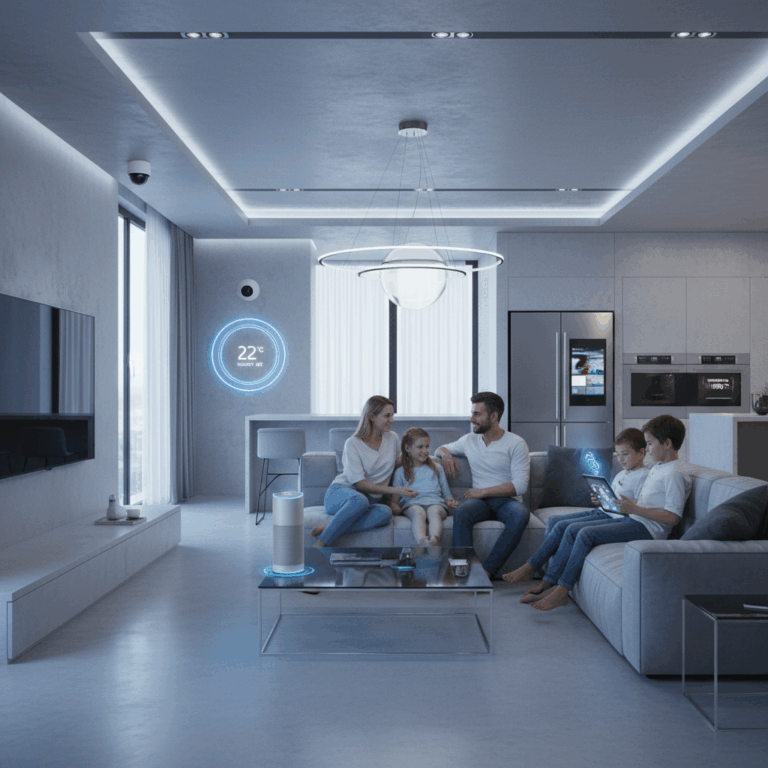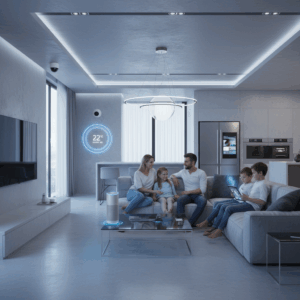Components of Smart Home Systems
A smart home system integrates various connected devices that communicate and function together to enhance everyday living. These systems rely on three main components: the central hub, communication protocols, and the devices themselves.
The central hub acts as a command center, directing smart devices and processing user inputs. Communication protocols ensure seamless interaction between devices, enabling automation and control.
Understanding these components is essential for appreciating how smart homes deliver convenience, security, and energy efficiency through technology.
Central Hub and Controllers
The central hub is the core of any smart home, managing commands and coordinating devices. It can be a dedicated device like Amazon Echo or Google Nest Hub, or an app on a smartphone.
This hub sends instructions via wireless protocols to connected devices, allowing users to control lighting, thermostats, or security systems from one place, either remotely or locally.
By centralizing control, these hubs facilitate automation and streamline interactions between multiple smart home products for an integrated experience.
Wireless Communication Protocols
Wireless protocols such as Wi-Fi, Bluetooth, Zigbee, Z-Wave, and Thread enable smart devices to communicate efficiently. Each protocol has strengths suited to different device requirements.
Wi-Fi supports high data transfer but consumes more power, while Zigbee and Z-Wave offer low-energy, longer-range communication ideal for sensors and lighting control.
Thread is an IP-based protocol designed for reliable, secure device networking, contributing to smoother interoperability among smart home components.
How Smart Homes Operate Daily
Smart homes function by integrating devices that interact continuously to optimize daily living. These devices collect data, communicate, and execute commands to enhance comfort and safety.
The operation revolves around three main activities: monitoring environmental conditions, managing devices remotely, and automating tasks through schedules and triggers. This improves efficiency and user convenience.
By leveraging sensors, wireless communication, and intelligent automation, smart homes create an adaptive environment that responds proactively to inhabitants’ needs throughout the day.
Monitoring through Sensors
Sensors are essential in smart homes for gathering real-time data on motion, temperature, light, and humidity. This information enables the system to make informed decisions.
They detect changes in the environment to trigger actions like turning lights on when someone enters a room or adjusting the thermostat based on occupancy and temperature readings.
These monitoring capabilities allow for increased home security, energy savings, and personalized comfort by continuously tracking user presence and environmental conditions.
Remote Management and Control
Remote management enables users to control and monitor smart devices via apps or voice commands from anywhere. This improves convenience and security dramatically.
Whether adjusting lighting, checking security cameras, or setting thermostat schedules, remote access ensures household control even when away, providing peace of mind and energy efficiency.
Smart assistants and smartphones act as gateways, sending commands through the home’s network to activate devices instantly or monitor live conditions remotely.
Automation and Scheduling
Automation lets smart homes operate devices based on pre-set schedules or triggered events. This reduces manual intervention and optimizes daily routines seamlessly.
For example, lights can turn on at sunset or heating switches off when residents leave, driven by learned preferences or programmed sequences to improve comfort and save energy.
Scheduling integrates all connected devices, enabling homes to react intelligently to changing conditions, improving convenience and ensuring efficient resource use.
Interoperability and Industry Standards
Interoperability is key to the seamless operation of smart home devices, allowing products from different brands to work together effortlessly. Industry standards play a crucial role in enabling this compatibility.
Without shared protocols and guidelines, smart home systems would face challenges in device communication and user experience. Standards ensure devices communicate securely and efficiently across various ecosystems.
As the smart home market grows, unified protocols simplify installation, improve reliability, and expand functionality by fostering collaboration among manufacturers and service providers.
Matter Protocol and Device Compatibility
The Matter protocol is an IP-based standard designed to unify smart home device communication. It addresses previous fragmentation by supporting interoperability between major ecosystems.
Developed collaboratively by Apple, Google, Amazon, and others, Matter enables devices to connect reliably, regardless of brand or platform, reducing compatibility issues for consumers.
This standard simplifies device setup and control, allowing users to integrate various smart products smoothly into their home network, enhancing overall user experience.
Matter supports multiple wireless technologies like Ethernet, Wi-Fi, and Thread, providing flexibility and robust connectivity options for diverse smart home environments.
Role of Major Industry Players
Leading technology companies such as Apple, Google, and Amazon have been instrumental in advancing smart home interoperability by endorsing and adopting shared standards like Matter.
These players contribute to developing open protocols that promote wider device compatibility, streamline product integration, and encourage innovation across the smart home industry.
Their collaboration fosters consumer trust and expands market growth by making smart home technology more accessible, reliable, and user-friendly worldwide.
User Interaction and Benefits
User interaction with smart home devices revolves around intuitive control methods that make managing home systems effortless and accessible. These interactions emphasize convenience and accessibility.
Smart homes empower users by offering multiple interfaces, including voice assistants and mobile apps, allowing control from anywhere, anytime, enhancing user experience and satisfaction.
Understanding these control options and their benefits sheds light on how smart homes transform day-to-day living through technology integration.
Control Interfaces: Voice and Apps
Voice control allows users to interact hands-free with smart devices using assistants like Alexa, Google Assistant, or Siri, making operations quick and natural.
Mobile apps provide a centralized platform for users to monitor, manage, and customize device settings remotely, offering flexibility and detailed control over home systems.
These interfaces complement each other, enabling effortless switching between voice commands and app-based controls for seamless user engagement.
As a result, controlling lighting, climate, security, and appliances becomes accessible to users of varying tech familiarity and physical ability.
Enhancing Comfort, Security, and Efficiency
Smart home devices improve comfort by adapting lighting, temperature, and ambiance to user preferences, fostering a personalized living environment.
Security is enhanced through smart cameras, doorbells, and sensors that alert users of unusual activities remotely, increasing home safety and peace of mind.
Energy efficiency is optimized via automation, with devices like thermostats adjusting heating and cooling based on occupancy, reducing waste and lowering bills.
Combined, these benefits make smart homes not only more livable but also safer and more environmentally conscious, offering tangible everyday advantages.







